Copyright by and reproduced with permission from Devon Peña, Professor of Anthropology,
University of Washington, Seattle WA.
Moderator’s Note: It is my privilege this time of the year to present the work of my undergraduate students at the University of Washington. This year I am presenting a series of outstanding blogs by students enrolled in my course on Environmental Anthropology. The large lecture format course introduces students to the field of environmental anthropology, which includes the study of Ethnoecology – the knowledge of ecology developed by indigenous and other traditional place-based peoples. The course also examines contributions from the fields of critical political ecology, which focuses on the role of science in the politics of environmental law, policy, and social movements. Finally, we study aspects of environmental history, which focuses on the role of human societies – both small- and large-scale – in processes of ecological change and includes analysis of the history of ideas about the quality of the human-environment relationship. Like the class, these blogs seek to bridge all these approaches and more by providing entries that address local place-based knowledge and situate Ethnoecology within the context of politics and history.
I am very proud of the work done by the students this year because they have demonstrated that the youth of the current ‘Millennial’ generation is as serious-minded and dedicated to creative and critical thought as any that preceded them. The students illustrate the value of collective work and the possibilities that unfold with collaborative group projects as part of a critical pedagogy that challenges the hyper-individualism of our mass society. It is refreshing to see these young minds create an intellectual community and contribute to the diffusion of the people’s knowledge of ecology.
I also acknowledge the incredible contributions by my two graduate assistants, Claudia Serrato and Gabe Valle. They supervised the entire process of research, preparation, and editing of these blog entries. The results of their professional guidance and dedicated support of my students are superb. I am blessed to have such high quality graduate students in my midst. I am also grateful to Erik Jaccard, who serves as our English-writing instructor, and was masterful and skilled in preparing these entries for publication.
The first in this series is by a group that focused on wild strawberry. The students found that the wild strawberry has been recognized and used by indigenous peoples since the dawn of time. Native Americans have valued the wild strawberry as food and medicine, recognizing it as a blood purifier. The students correctly assert that Native Americans also have a spiritual understanding and relationship with the groundcover plant as illustrated by the Anishinaabe name for the wild strawberry, odeiminidjibik, which translates as “root of the heart” and illustrating the intimacy of the people and this wild berry.
The students also learned that “traditional environmental knowledge of the wild strawberry has been lost through the industrialization and domestication.” They conclude that “[c]ommercial strawberries as we know them today have lost their fundamental essence through genetic modification and nutritional degradation.” There is a growing movement to protect and restore the wild strawberry and people’s knowledge of this sacred and intimate fruit.
Wild Strawberry (Fragaria)
SACRED PURIFIER IS A FIRST SIGN OF SPRING
Grace Kim | Elizabeth Szorad | Edwin Chen | David Linney | Ana Laakmann
The wild strawberry, or Fragaria, of the Pacific Northwest is a species of plant that has played a large role in traditional indigenous cultures and continues to be a hugely influential crop today. In this blog, we seek to explore the effects of modernization and agricultural domestication of wild strawberries.
The wild strawberry has long been widely used by native cultures and by examining their traditional environmental knowledge of the strawberry we hope to shed light on this spiritually and economically important resource. We will explore the environmental history of strawberries, with a focus on the domestication and cultivation of wild strawberries through genetic engineering. In this exposition, we will address the issue of a market-driven focus being the driving force behind creating the most profitable strawberry, which has led to the neglect of local indigenous knowledge of wild strawberries. We want the readers of our blog to understand that strawberries have deep history of traditional knowledge and use that has been overwhelmed by the cultivation of domesticated strawberries.
Fragaria, a genus of the flowering plants within the Rosaceae family, is more commonly known as strawberry for its characteristic red and sweet fruit. Classified within the most diverse group of land plants, the angiosperms, Fragaria falls into the Rosales order as part of the Rosaceae family, alongside many other edible fruits such as apples, cherries, peaches, and pears. Worldwide, there are more than twenty different species of Fragaria as well as subspecies, with the main difference in classification due to the various numbers of chromosomes.
All strawberries have a base haploid count of seven common types of chromosomes, with exhibition of different polyploidy. Many species are Diploid, meaning they have two sets of the seven common chromosomes. The ploidy number can increase as high as ten in certain Fragaria species. Strawberry species with a larger number of chromosomes bear larger plants with larger berries, which will prove to be an important factor in the creation of the common garden strawberry through commercial production.
Another interesting fact about the strawberry is that it is not actually a berry. A berry is botanically defined as a fruit produced from a single ovary, but the fleshy part of the strawberry forms the receptacle that holds the ovaries. The tiny “seeds” seen on the outside of the Fragaria fruit is actually one of the ovaries, with a seed inside it.
There are three Fragaria species that are found Native to the Pacific Northwest. The most common of the three is the Fragaria vesca, known more prominently as the woodland strawberry. This is the most popular wild strawberry, as it can be found in many places ranging from woodlands, forests, and clearings to roadsides, stone and gravel laid paths, and hillsides. Due to its range of habitation, the woodland strawberry serves as a significant food source for animals with its leaves and fruits, as well as natives of the land (Munger).
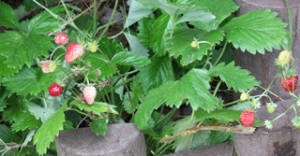
Another important fact about the woodland strawberry is that due to its diploid polyploidy, it is a small plant bearing a significantly smaller fruit compared to the popular domesticated strawberry. However, it plays a huge role as an indicator plant for diseases that affect the domesticated strawberry and as a genetic model plant for research of the Rosaceae family. This is due to its small genome size, shorter reproductive cycle, and ease of propagation (Shulaev). The commercially produced garden strawberry has generally replaced Woodland strawberry since the early 17th Century. In this blog entry, most mention of wild strawberry usage by the native people of the Pacific Northwest can be generally assumed to be the Fragaria vesca.
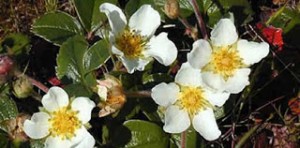
The other two native strawberries found in the Pacific Northwest are the Fragaria chiloensis and the Fragaria virginiana. Known popularly as the Coastal strawberry, F. chiloensis has a large natural range along the coast of the Pacific Ocean from North to South America, with appearances in Hawai’i, Chile, and Argentina due to migratory birds dispersing seeds (USDA). Noted for its large berries among the Fragaria species, it is one of two species of Fragaria used to create the modern domesticated Garden Strawberry.
The Fragaria virginiana is the second berry used to create the Garden Strawberry, its natural range is only within North America (USDA). The Virginia strawberry is known for its sweetest fruit among the wild strawberries, and it is found within fields and dry openings. Both the F. virginiana and the F. chiloensis are octoploid. Together, the sweetest and the largest berry are bred to create the common garden strawberry, the Fragaria ananassa. Commercially, the garden strawberry has replaced all wild strawberry as the worldwide-cultivated strawberry. Recently, researchers have been trying to cross the Fragaria ananassa with the Fragaria vesca in an effort to combine and create the best traits of the all strawberries (Bauer).
Strawberries have a diverse background and history; they can be seen as unique species that have survived forest degradation, habitat destruction, and even DNA alterations. The Woodland Strawberry is more of the smaller breeds and archaeological digs suggest that humans have consumed the woodland strawberry since the Stone Age (Schlosser). The woodland strawberry was first cultivated in ancient Persia where farmers knew it as “Toot Farangi” (Brody). Its seeds were later taken towards the Far East and to Europe where it was widely cultivated until the 18th century.
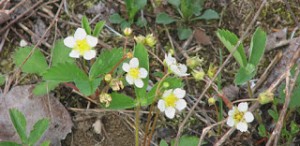
The wild strawberry grows in most regions of the United States and is one of two species of strawberry that were hybridized to create the modern domesticated Garden Strawberry. Throughout history strawberries have been very beneficial to the environment and have a mutual relationship with different animal species; for example birds, deer, squirrels and other animals eat the strawberry fruit and help distribute the seeds to other areas. This helps them replenish their roots in different soil regions.
Wild strawberries were part of the diet of Native Americans in the United States. The fruit was eaten raw, dried out or even cooked. Some tribes used the plant leaves to make a tea. Strawberries were always seen in the farmers’ gardens and provided sustenance for wildlife. Another strategy indigenous people used with this fruit was to use it to draw wildlife closer. Today it seems that society has forgotten about this traditional ecological knowledge about the strawberry and now has become an industry and placed as a beneficial crop to cultivate for profit.

Nutritionists have labeled strawberries a nutritional “superfood,” a result of it being an excellent source of antioxidants, Vitamin C, potassium, folate and fiber (World’s Healthiest Foods). It is only in recent times that the strawberry has become increasingly available year-round and is more naturally available during the spring and summer time. The reason for this convenience is an antifreeze gene from the Arctic flounder that has been introduced into strawberries to extend their growing season in northern climates.
Dr. Steven Kresovich, a plant breeder at Cornell, says, ‘‘Genes should be characterized by function, not origin. It’s not a flounder gene but a cold tolerance gene that was introduced into strawberries’’ (Brody). This scientist is trying to state that this GMO (Genetically Modified Organism) does not affect the taste or texture and is just a means of allowing it to be commercially sold due to higher demand. But something that is not widely known to the public is that there is a difference of nutrients when comparing the today’s strawberries of today with those from the past when indigenous people cultivated them.
Commercial food processing can dramatically lower the nutrient content of strawberries. There is a lot more industrial work even with “organic” strawberries; heat, changes in acidity during processing, oxygen exposure, light exposure, and the mechanical impact of processing.
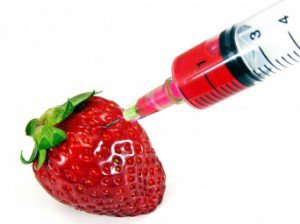
There is a saying that indigenous tribes have about the strawberry, “The wild strawberry is the first berry food to appear in the spring and this sacred plant is gathered at that time and eaten as a blood purifier…” (Mohawk). In the eyes of indigenous culture, strawberries that are known to the public have gone through nutritional degradation and though they seem like a “normal” strawberry that has been untouched by time, the reality is that it has been altered and therefore its traditional values destroyed. Just because it may taste, look, and smell the same as a natural strawberry, inside it’s DNA is different which is most likely causing different impacts on the environment and to our bodies.
Wild strawberries have been an important medicinal remedy for both indigenous Native American cultures as well as modern western culture because of their rich nutritional properties. The medicinally relevant parts of this plant include the berry, the leaves and the roots as well. As well as being a modern “superfood”, wild strawberries are high in vitamin C, which was understood to fight off sickness even before the advent of modern medicine (Reid).
The most common use of wild strawberries by native peoples was as a treatment for burns and sores. Often the leaves were chewed or dried, then applied to the burn as a healing remedy. For sores, the ground up strawberry leaves were often used in conjunction with a fatty substance, deer fat is one example of this (WSDOT). The roots were frequently chewed in order to help clean teeth and to treat gum inflammations. The roots can also be used to brew tea, which many indigenous cultures believed helped with urination problems, diarrhea, and stomach issues (Plant Life). Wild strawberry leaves also played a role in the health of newborn babies. Some Native American tribes would dry the leaves by a fire, powder them and apply them to the unhealed navel region of the infant in order to help prevent infection (WSDOT). The fruit was also eaten as medicine; this was supposed to help with the treatment of arthritis, tuberculosis, scurvy, and even rheumatism (Health From Nature).
While the use of wild strawberries for medicinal purposes was more commonplace in Native American cultures, the use of strawberries in medicine can still be seen in modern western culture. Today we still use wild strawberries as a source of many nutritionally important vitamins, such as vitamin C, as well as essential oils and minerals. Today, wild strawberries are still eaten, or the roots are used to brew medicinal teas. Wild strawberries still grow wild all over the Pacific Northwest, and have become a symbol for modern peoples in the Pacific Northwest region (Brill). Due to their important medicinal and nutritional properties, strawberries are strongly tied to the cultural traditions of many Native American tribes.
Humans have depended on the abundance of strawberries for hundreds of years. More specifically, tribes in the Pacific Northwest continue to rely on this berry for their cultural identities. Strawberries have a deep spiritual connection with tribes because they symbolize love. The Anishinaabe tribe calls the berry “odeiminidjibik,” meaning root of the heart, illustrating the intimacy of the berry (Timpanelli).
Family units in tribal communities are exceedingly important: In order to establish a secure environment, love must be present to nurture the family. The strawberry in a way represents the collective spirits of tribes, reflecting their knowledge about the environment, sustainable living and survival (Turner, 200). The intimate relationship with strawberries underlies reasons to preserve and value the berry.
In the spring the berry purifies the lands as tribes use this period to celebrate the renewal of life, symbolized through the abundance of strawberries on the land (Native American Strawberry Mythology). This berry is a sacred blessing that reminds tribes that prosperity will continue as long as individuals support and love one another. Also, strawberries gathered during this period are used in ceremonies, rituals, potlucks and everyday tribal life. For example, strawberries can be used to dye fabric and pottery to decorate wedding ceremonies or feasts. In order for tribes to seize the medicinal and nutritional opportunities strawberries provide, they must use their cultural and place-based knowledge to identify the regions where strawberries can be found.
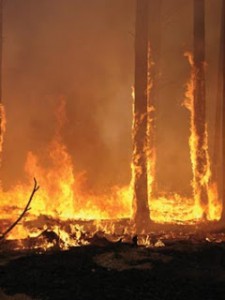
Generations of observations on the land have revealed certain patterns the strawberry possesses. For example, strawberries flourish in areas recovering from brush or forest fires (Turner, 213). Tribes had to learn when and where strawberries were located to enhance cultivation. This characteristic of strawberries was observed throughout tribes given the traditional name of “noon tak tek hah kwa,” meaning growing where the ground is burned (Timpanelli).
Ultimately, tribes had to use their traditional ecological knowledge to improve the yields of berries to carry on tribal traditions. If nothing were learned through the observations of strawberries; this berry would not have been as valued revealing the importance of place-based knowledge. Also, to successfully cultivate, harvest and cook strawberries one must learn how to properly do so by understanding the place-based knowledge deeply rooted within the area. Tribes have learned the seasons and cycles of strawberry production and passed that information down to younger generations. That knowledge that indigenous people developed and acquired on strawberries reflects their understanding and connection to the environment they live on. Tribes were able to manage, maintain and enhance strawberries through natural observations and understandings.
Indigenous cultural knowledge of strawberries has led to enhancements in storing this berry through the winter. Tribes learned that the plant was not able to produce strawberries during the winter, so new methods of storing strawberries were studied. Extra harvest could be stored through the winter by freezing the berries or creating jams/preserves. (Recipe for strawberry Jam).
Ultimately, the spiritual importance of strawberries underlies the traditional ecological knowledge that tribes have about the environment. The abundance of strawberries provided several tribes in the Pacific Northwest with subsistence for many generations. Strawberries are part of indigenous culture and are respected and preserved for future generations to learn about and enjoy. In order to not lose the cultural and place-based knowledge gained from observing wild strawberries, indigenous groups must strive against modernization and genetic modifications to continue their traditions.
Strawberries began as a wild plant but, like most things in the United States today, have been converted to a social commodity. Firms seeking to make a profit from everything, always search for bigger and better products and, with a growing economy, trying to make their products superior to others on the market. Wild Strawberries, also known as the “heart-seed berries” because of their medical value, have become a big economic asset to the west coast, where a good climate for growing exists.
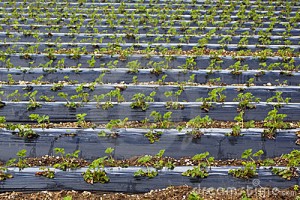
Today, strawberries begin in plastic, and end in plastic. Before planting an entire field is sealed with plastic sheeting and injected with Methylbromide, a chemical concoction that kills harmful microbes and Nematodes. This process, in addition to being highly artificial is highly expensive. Strawberries are not of the best economic value; growers who produce specialty crops do not benefit directly from any government price supports. They may gain an annual profit of $10,000 to $20,000 an acre, while the cost of production may be anywhere from $12,000 to $30,000, depending on how much employees are paid and equipment costs (Schlosser).
Due to the large cultivation and plantation of strawberries, Native Americans have neglected the traditional knowledge and spiritual bond between strawberries. Archeologists from the Burke Museum at the University of Natural History from Washington and King County teamed up in a project to find traditional environmental foods of the Pacific Northwest; primarily for the Tulalip, Muckleshoot, and Suquamish tribe (Krohn, and Segrest). The main purpose of this study was to improve the overall health of Coastal Native American Tribes.
These Native Americans have struggled with diabetes from the declining Traditional Environmental knowledge they formerly possessed of native fruits and vegetables. Today, they are 5 to 8 times more likely to have type II diabetes. Also, since steps were only recently taken to improve Native Americans traditional rights, toxins have spread all over formal ancestral grounds; Berry fields are sprayed with pesticides if near clearcuts, insecticides and herbicides are commonly sprayed in public areas, and current harvest locations are sometimes located on previous dump sites which carry seeped toxins that are leached into plants roots.
 Struggling from loss of land and rights, new regulations requiring that Indian people get a permit to harvest forest products, such as wild strawberries, cost these people additional increments of valuable time and money as well (Krohn, and Segrest). Recently, steps are now being taken by the WFPA to regulate forest activities to protect wildlife and the forest surrounding these areas (“WFPA”). The Department of Archeology & Historic Preservations also requires, for any harvesting on a Native American archeological site, a permit from DAHP and a meeting with the affected tribe, where an agreement of cultural resources, referred to as a protection plan must be met (“DAHP”).
Struggling from loss of land and rights, new regulations requiring that Indian people get a permit to harvest forest products, such as wild strawberries, cost these people additional increments of valuable time and money as well (Krohn, and Segrest). Recently, steps are now being taken by the WFPA to regulate forest activities to protect wildlife and the forest surrounding these areas (“WFPA”). The Department of Archeology & Historic Preservations also requires, for any harvesting on a Native American archeological site, a permit from DAHP and a meeting with the affected tribe, where an agreement of cultural resources, referred to as a protection plan must be met (“DAHP”).
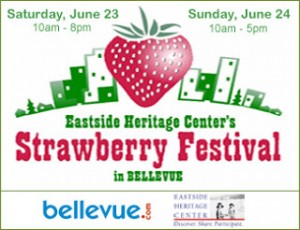
Showing its appreciation of the native strawberry, Bellevue celebrates an annual festival called the Eastside Heritage Center’s Strawberry Festival. Here, families from all over the Northwest come to play games, rejoicing and remembering when strawberry farming was one of the region’s most famous activities (“Eastside Heritage Center”).
The traditional environmental knowledge of the wild strawberry has been lost through the industrialization and domestication of the species. Commercial strawberries as we know them today have lost their fundamental essence through genetic modification and nutritional degradation. We must take into account how much the strawberry has changed over the past few hundred years, this not only impacts humans, but this impacts the world at large because of the interconnectedness of the life cycles of all species.
Works Cited
Bauer, A. 1993. “Progress in breeding decaploid Fragaria × vescana”. Acta Hort. (ISHS) 348: 60-64
Bickers, Chris. “U.S. Berry Exports Unprecedented.” Southeast Farm Press. Penton Media, n.d. Web. 05 Nov. 2012. <http://southeastfarmpress.com/markets/us-berry-exports-unprecedented>.
Brill, Steve. “Wild Strawberry (Fragaria Virginiana).” Stalking the Wild Dandelion. Steve Brill, n.d. Web. 05 Nov. 2012. <http://www.wildmanstevebrill.com/Plants.Folder/Strawberry.html>.
Brody, Jane E. “PERSONAL HEALTH; Gene Altered Foods: A Case Against Panic. The New York Times, 05 Dec. 2000. Web. 14 Nov. 2012. <http://www.nytimes.com/2000/12/05/health/personal-health-gene-altered-foods-a-case-against-panic.html?pagewanted=all>.
“Ethnobotany – Herbs.” WSDOT – Ethnobotany – Herbs. Washington State Department of Transportation, n.d. Web. 05 Nov. 2012: http://www.wsdot.wa.gov/Environment/CulRes/herbs.htm.
Fontaine, Cory. “Odamin or The Heart Berry Story.” Cartoon. Keweenah Bay Ojibwa Community College. N.p., n.d. Web: http://kbocc.org/index/index.php/homeside.
“In the Strawberry Fields.” The Atlantic. N.p., n.d. Web. 14 Nov. 2012: http://www.theatlantic.com/magazine/archive/1995/11/in-the-strawberry-fields/305754/.
Munger, Gregory T. (2006). “Fragaria vesca”. Fire Effects Information System. U.S. Department of Agriculture, Forest Service, Rocky Mountain Research Station, Fire Sciences Laboratory. Retrieved 2008-08-06.
“Native American Strawberry Mythology.” Native Languages of the Americas, 2009. <http://www.native-languages.org/legends-strawberry.htm>. (accessed Nov. 12 2012).
N.p., n.d. Web. 14 Nov. 2012. <http://www.whfoods.com/genpage.php?tname=foodspice>.
“Plant Profiles.” College of Arts and Sciences. Seattle University, n.d. Web. 05 Nov 2012. <http://www.seattleu.edu/artsci/ethnobotanical/default.aspx?id=15856>.
“Plants.” Fragaria. N.p., n.d. Web. 14 Nov. 2012. <http://www.portlandnursery.com/plants/natives/fragaria.shtml>.
Reid, Sara, Van Wishingrad, and Stephen McCabe. Plant Uses: California. Rep.Arboretum Santa Cruz, June 2009. Web: <arboretum.ucsc.edu/pdfs/ethnobotany_webversion.pdf>.
Shulaev, Vladimir; et al. (Dec. 2010), “The genome of woodland strawberry (Fragaria vesca)”, Nature Genetics 43 (2): 109–116.
Timpanelli, Veronica. “Wild Strawberries .” <http://suite101.com/article/wild-strawberries-a123828.> (accessed Nov. 12, 2012.)
Turner, Nancy J., Luczaj, Lukasz J., Paola Migliorini, Andrea Pieroni, Angelo L. Dreon, Linda E. Sacchetti, and Maurizio G. Paoletti. “Edible and Tended Wild Plants, Traditional Ecological Knowledge and Agroecology.” Reviews in Plant Sciences 198-225. 2011.
USDA, ARS, National Genetic Resources Program. Germplasm Resources Information Network – (GRIN) [Online Database]. National Germplasm Resources Laboratory, Beltsville, Maryland. URL: http://www.ars-grin.gov/cgi-bin/npgs/html/taxon.pl?267 (14 November 2012)
USDA, ARS, National Genetic Resources Program. Germplasm Resources Information Network – (GRIN) [Online Database]. National Germplasm Resources Laboratory, Beltsville, Maryland. URL: http://www.ars-grin.gov/cgi-bin/npgs/html/taxon.pl?264 (14 November 2012)
“Using the Berry Plants for Nutrition and Medicine.” Using the Berry Plants for Nutrition and Medicine. N.p., n.d. Web. 14 Nov. 2012. <http://www.indigenouspeople.net/berry.htm>.
“Wild Strawberry – Fragaria Virginiana.” Wild Strawberry – Fragaria Virginiana. Plant Life.Org, n.d. Web. 14 Nov. 2012. <http://montana.plantlife.org/species/fragaria_virgin.htm>.
“Wild Strawberry – Fragaria Vesca | Medicinal Use, Description and Other Useful Information about Wild Strawberry.” Wild Strawberry – Fragaria Vesca Medicinal Use, Description and Other Useful Informations about Wild Strawberry. Health From Nature, n.d. Web. 14 Nov. 2012. <http://health-from-nature.net/Wild_Strawberry.html>.
Krohn, Elise, and Valerie Segrest. “The Traditional Foods of Puget Sound Project.” Northwest Indian College. N.p., n.d. Web. 12 Nov 2012.
Schlosser, Eric. “In the Strawberry Fields.” The Atlantic. The Atlantic, n.d. Web. 12 Nov 2012. <http://www.theatlantic.com/magazine/archive/1995/11/in-the-strawberry-fields/305754/.>.
“Bellevue Strawberry Festival.” Eastside Heritage Center. N.p.. Web. 12 Nov 2012. <http://www.bellevuestrawberryfestival.org/Home.asp>.
“Forest Practices Act.” DAHP. N.p.. Web. 12 Nov 2012. <http://www.dahp.wa.gov/forest-practices-act>.
“Washington’s Forest Practices are Some of the Toughest in the Nation.” WFPA. N.p.. Web. 12 Nov 2012. <http://www.wfpa.org/page/regulatory-environment/>.
________________________________________
About Devon G. Peña
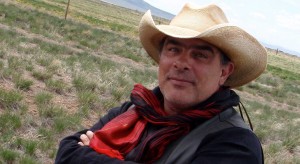 A lifelong activist in the environmental justice and resilient agriculture movements, Devon G. Peña is a Professor of American Ethnic Studies, Anthropology, and Environmental Studies at the University of Washington in Seattle. He also works on the family’s historic acequia farm in San Acacio, Colorado.
A lifelong activist in the environmental justice and resilient agriculture movements, Devon G. Peña is a Professor of American Ethnic Studies, Anthropology, and Environmental Studies at the University of Washington in Seattle. He also works on the family’s historic acequia farm in San Acacio, Colorado.
A pioneering interdisciplinary research scholar and widely-cited author, his most recent books include Mexican Americans and the Environment: Tierra y Vida (U. of Arizona Press, 2005) and The Oxford Encyclopedia of Latinos and Latinas in the United States (senior editor, Oxford University Press, 2005).
Dr. Peña is the Founder and President of The Acequia Institute, the nation’s first Latina/o charitable foundation dedicated to supporting research and education for the environmental and food justice movements.
Read this article as it was originally published here.

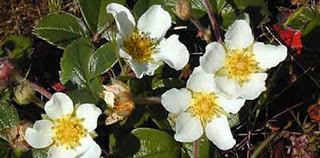
Ronald,
I’m afraid I have no contacts in North Carolina, however you might check out some of these links.
http://www.wildfoodadventures.com/northcarolina.html
http://momvoyage.hilton.com/articles/foraging-for-food-wild-mushrooms-in-asheville/
http://mountainx.com/bulletin/found-food-foraging-for-wild-edibles-in-wnc/
I hope you find some wild berries!
Gail N-K
GoodFood World
We are trying to find some good locations in our area of western North Carolina, where we might find wild strawberry plants. My wife is from eastern Ukraine, and is familiar with the healing powers of wild strawberries, and is interested in finding some to treat her health issues. If you have any contacts in our area, or know of any locations, we would greatly appreciate any information you could share with us. We live in Rutherford County, which is in the foothills.
Thank you